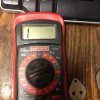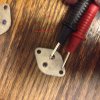Now flip your leads with
Black (Negative) on base red (Positive) on collector. You know that all your transistors are not bad so you should be able to see a difference if you find a bad one. Your first set you kind of
jumped around (Highlighted in red). Stay consistent. Do all of them one way, then all of them the other way. Check them thouroughly... Ie...
Red collector Black base
all of them
Red collector Black emitter
all of them
Red to emitter black to base
all of them
SWAP LEADS AND DO IT AGAIN
Black collector red to base
Black to collector red to emitter
Black to emitter red to base
That's 6 checks per transistor
You will see a pattern, you will see your failure if you are consistent and thorough. If you make yourself a drawing, you can easily keep track of reading. Don't let the drawing confuse, one lead is red (+) one is black(-) but you can see there is 6 ways to check each transistor. This transistor shows 3 pins (you can use this on your control board) but your backplane transistors have 2 pins and the case is considered a pin. The results you see in the diagram may not be your results. They are examples. They will change from an NPN to a PNP tranny
View attachment 23483



